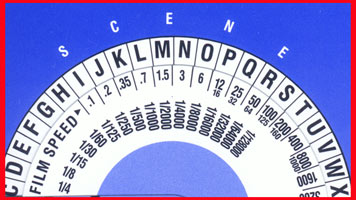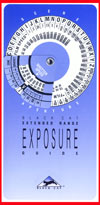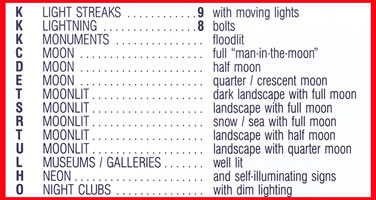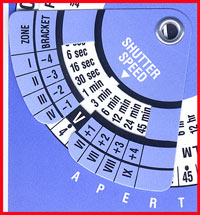MORE INFORMATION Bracketing I highly recommend bracketing. This is, after all, a GUIDE. This GUIDE will get you close (usually within a stop or two) and will save from from wild guessing or excessive bracketing.
You can pick any aperture you want and read the corresponding shutter speed(s). If you want to bracket by changing
apertures, move the triangle until the shutter speed you want appears in the window. Use the aperture in the notch and then try apertures on either side of that. Of course you have to pick a useable aperture for your scene
and the film you are using. With 100 speed slide film, you won't be able to get a photo of a moonlit landscape with a shutter speed of 1/60 second, no matter what aperture you choose. SCENES There are over 70 scenes listed in the GUIDE, enough that one of them should be close to what you are going to photograph.
The GUIDE includes a wide variety of both indoor (circus, ice shows, hospital nurseries, night clubs) and outdoor (fireworks, star trails, Christmas trees) scenes for both day and night. The fourteen scenes shown above are just a
few of the scenes shown in the guide. Reciprocity Failure Note that the shutter speeds are not linear
at longer shutter speeds (i.e. 1 minute, 2 minutes, 4 minutes, 8 minutes, and so on). That is because the BLACK CAT EXPOSURE GUIDE allows for reciprocity failure of film (film starts slowing down at long exposures and responds more
slowly to light).
WHERE TO BUY
The Black Cat web site with all of their products is here. The Exposure Guide is here Leonard Lee Rue has the BLACK CAT EXPOSURE GUIDE in his catalog and
on his web site (home page). The specific page on his site with the Black Cat Guide is here.
March 7, 2001
Updated April 9, 2005 |







